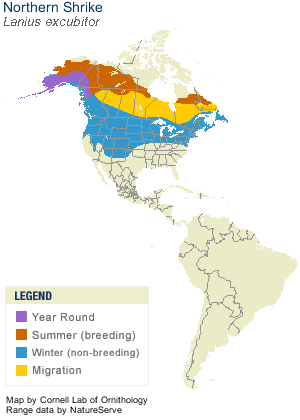The northern shrike, Lanius excubitor, – also known as the great grey shrike in Europe – belongs to the Laniidae family, within the oscine passerines (songbirds) (Sibley, 2003). The main features that place the northern shrike within the songbirds are their ability to perch and produce elaborate bird songs.
The northern shrike is a medium-sized songbird, with a length of 22 to 26 cm (BeautyofBirds). They have a grey back and whitish throat and chest. Their light coloured body makes their black features stand out nicely (Cornell, 2015). The black wings contain white patches and the outer tail feathers of the black tail are white too (Cornell, 2015). As adults they also have a noticeable black mask. The juveniles are very similar to the adults, but are browner, with distinct barring on their chest and have a less prominent mask (Cornell, 2015). The song of the northern shrike is characterized by a series of repeated short phrases that may sound thrasher-like. They also produce a distinct call when alarmed, which can be heard in the following soundtrack from the Cornell lab (2015):
Most distinct features between the loggerhead (above) and northern (below) shrike (Birdorable, 2008)
Northern shrikes can be easily mistaken with another shrike species that occurs in North America, the loggerhead shrike (Sibley, 2003). Unless seen through binoculars it would be very hard to distinguish these two birds. Luckily, the loggerhead shrike is a rare sighting around Canada, especially within the winter season (Sibley, 2003). You can see the most distinct features between the two birds described in the image to the right.
The northern shrike breeds in northern Europe, Asia and in North America during the summer months, most likely found in open spruce woods (Sibley, 2003; BeautyofBirds). A female will lay 4-9 eggs in a deep open cupped nest made out of twigs and roots and lined with grasses, small feathers and animal hair (Cornell, 2015). The nest is so deep that one would only see the tip of the female’s tail during the 15-17 days of incubation (Kaufman). Once hatched, the baby birds are fed by both parents for about 19-20 days, by which they leave the nest (Kaufman). The parents continue taking care of their young for several weeks after that (Kaufman).

Range map of the northen shrike in North America (Cornell, 2015)
Once breeding season is over, they migrate south to overwinter. In North America they are found all across southern Canada and in part of the northern United States during this season. Although they might migrate in groups, the northern shrikes are solitary birds. When they arrive at a location they quickly disperse to reduce competition and establish their hunting territory (BeautyofBirds).
Although shrikes are very cute, you should not be fooled by their appearance – they are actually stone-cold killers. Shrikes are predatory birds, which prey upon large insects, rodents and even other small songbirds (Cornell, 2015). They are also found to eat lizards, frogs and snakes in Eurasia (Kaufman). Their name, Lanius exubitor, is latin for butcher watchman, which is given to them because of their hunting and feeding behaviour (Cornell, 2015). They are usually found at the very top of trees or brushes in an open field, from which they scout the land for anything that moves (Cornell, 2015). Once spotted, the shrike seizes their prey near the ground with either their feet or hooked bill – breaking the neck of any vertebrates – before impaling them on a pointy object (Kaufman). They usually use thorns, spines or barbed wire to impale their prizes – sometimes while they are still alive – from which they either tear them apart for consumption or cache them to eat later (Cornell, 2015).
The northern shrike’s conservation status is of least concern by the IUCN (International Union for Conservation of Nature). Even so, their populations must still be monitored. Other shrike species around the world are showing declines, such as the loggerhead shrike, which is decreasing in numbers mainly due to habitat loss (Bellemore, 2010).
Literature Cited
Cornell Lab of Ornithology. 2015. Northern shrike. Cornell University. Retrieved October 30, 2015, http://www.allaboutbirds.org/
BeautyofBirds. 2011. Great grey shrikes aka northern shrikes. Avianweb. Retrieved October 30, 2015, http://beautyofbirds.com/
Bellemore, C. and Grenville Land, S. C. 2010. The loggerhead shrike – an indication of how life has changed in rural eastern Ontario. Informart, St. Lawrence, Ontario
Birdorable. 2008. Spot the differences. Birdorable. Retrieved November 1, 2015, http://www.birdorable.com/
IUCN. Retrieved November 1, 2015, http://www.iucnredlist.org
Kaufman, K. Northern shrike: Lanius excubitor. National Audubon Society. Retrieved October 30, 2015, https://www.audubon.org
Noll, P. Birds likely to be observed in Oregon. Retrieved October 31, 2015, http://www.paulnoll.com/Oregon/Birds/
Sibley, D.A. 2003. The Sibley: field guide to birds of Western North America. Alfred A. Knopf, Toronto p. 294-295


Yikes!! I had no idea they impaled their food!! I’d never thought about how they foraged.